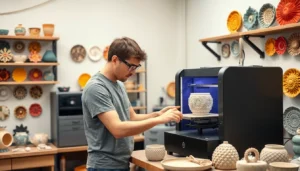Table of Contents
Toggle3D printing is like magic—turning digital dreams into tangible objects with just a few clicks. But just like any wizardry, it comes with its fair share of hiccups. From spaghetti-like filaments to prints that mysteriously vanish, the journey from idea to reality can sometimes feel like an obstacle course designed by a prankster.
Don’t worry, though! Every 3D printing enthusiast has faced these common problems. Understanding them is the first step to mastering the art of printing. Whether it’s a pesky clog or a bed adhesion issue, these challenges can turn your creative adventure into a comedy of errors. Let’s dive into the quirks and quibbles of 3D printing, and arm yourself with the knowledge to conquer these pesky pitfalls with a smile.
Overview Of Common 3D Printing Problems
3D printing presents several challenges that users frequently encounter. Filament tangling often leads to frustrations, inhibiting smooth printing experiences. Extruder clogs disrupt the material flow, which results in incomplete prints. Layer adhesion issues can cause parts to separate, compromising overall model integrity.
Warping occurs when corners of prints lift off the bed. Cooling improperly can exacerbate this problem, especially with materials like ABS. Over-extrusion creates excess filament that may cause blobs or zits on surfaces. Under-extrusion reduces detail and results in weak structural elements.
Stringing affects the quality of completed models. Thin strands of filament appear between parts, creating unwanted artefacts. Inconsistent extrusion causes variation in layer thickness, leading to visible imperfections. Support structures may also fail if not designed correctly, compromising the print’s stability.
Temperature settings play a crucial role in print success. Incorrect hot end temperatures influence filament viscosity. Bed adhesion can lessen too, affecting the first layer’s grip. Environmental factors like drafts or temperature fluctuations may worsen print performance.
Calibration mistakes contribute to many printing failures. Bed leveling needs regular adjustments for optimal contact with the nozzle. Incorrect print speed affects layer bonding, while improper acceleration settings can introduce vibrations, impacting precision.
Adopting best practices strengthens users’ ability to navigate 3D printing challenges successfully. Consistent monitoring and troubleshooting reduce the likelihood of encountering these common issues during projects. Understanding these problems leads to smoother printing experiences and improved outcomes.
Printing Issues
Several common issues arise during 3D printing processes, impacting print quality and outcomes.
Layer Adhesion Problems
Layer adhesion problems often lead to print failures. Insufficient bonding between layers can cause prints to separate or break easily. Factors such as incorrect temperature settings and poor material selection contribute to these issues. Adjusting the nozzle temperature or increasing print speed can help improve adhesion. Using an appropriate build surface, like a heated bed or adhesive spray, also enhances layer bonding. Persistence in monitoring and tweaking settings can lead to successful prints with solid structural integrity.
Warping Challenges
Warping challenges frequently afflict 3D printing projects. As the material cools, it contracts, which can cause corners to lift and create uneven surfaces. Various factors influence warping, including improper bed leveling and inadequate temperature settings. Utilizing a heated bed can minimize temperature differences, reducing the risk of warping. Furthermore, selecting the right filament type, such as ABS for its lower shrinkage, can also help combat this issue. Regular calibration and careful environmental control contribute to smoother printing experiences and more reliable finishes.
Calibration Errors
Calibration errors can significantly impact print quality in 3D printing. Common issues stem from improper bed leveling and nozzle clogs.
Bed Leveling Issues
Bed leveling issues lead to inconsistent first layers. Without a level build surface, prints can suffer from poor adhesion. Users often experience problems like warping and shifting layers when the bed isn’t level. A good practice involves using a piece of paper to gauge nozzle distance from the bed. Adjusting the bed regularly based on the filament type can enhance overall print quality. Ensuring the prints stick properly to the bed also helps prevent further complications. Consider checking the bed level before each print to maintain optimal results.
Nozzle Clogs
Nozzle clogs disrupt extrusion flow and affect print consistency. Filament jams can occur from dust, debris, or incompatible materials. Regularly cleaning the nozzle can mitigate these issues. Utilizing a cleaning filament once in a while proves beneficial for maintaining nozzle health. Additionally, adjusting print temperatures can prevent excessive cooling and reduce clogging risks. Observing the extrusion during the first few minutes can help identify potential clogs early. Keeping a routine maintenance schedule ensures smoother printing and better outcomes.
Material Problems
Material problems in 3D printing can significantly hinder the printing process. Issues such as filament quality and temperature settings frequently arise, requiring decisive action to avoid defects in prints.
Filament Quality Concerns
Filament quality directly affects print success. Low-quality filaments often exhibit inconsistencies in diameter and material composition, leading to extrusion difficulties and poor adhesion. They may also introduce impurities, which result in warping or discolored prints. Investing in high-quality filaments from reliable suppliers minimizes these risks. A filament that is too brittle can break during printing, while one that is too soft may not hold shape. Checking filament storage conditions helps preserve its integrity through reduced moisture absorption.
Temperature Settings
Temperature settings play a crucial role in achieving the desired print quality. An incorrect nozzle temperature can lead to under-extrusion or over-extrusion, affecting the overall appearance of the model. Additionally, not heating the print bed adequately can cause warping or poor adhesion. Each filament type has a recommended temperature range; thus, adjusting settings based on the material ensures optimal results. Regularly calibrating the printer’s temperature settings prevents discrepancies during the printing process. Monitoring ambient conditions such as drafts can also influence temperature stability, affecting print consistency.
Troubleshooting Tips
Addressing 3D printing problems involves focused troubleshooting tactics that ensure better results. Following these strategies can help overcome typical issues.
Regular Maintenance
Regular maintenance enhances the reliability of 3D printers. Clean the nozzle frequently to prevent clogs that disrupt extrusion flow. Check the filaments for dust or debris that could affect print quality. Schedule periodic inspections of the printer components, including the hotend and extruder gears, to ensure optimal performance. Lubricate moving parts as needed to maintain fluid movement. Use quality filaments from reputable suppliers to minimize risks of tangling or breaking.
Adjusting Print Settings
Adjusting print settings significantly impacts print outcomes. Start by fine-tuning temperature settings; correct nozzle temperatures prevent under-extrusion and over-extrusion. Modify print speed to suit filament types, balancing between speed and quality. Layer height adjustments can also enhance adhesion and overall appearance of prints. Monitoring cooling fan speeds is crucial for preventing warping and achieving better layer bonding. Incorporating these adjustments leads to smoother prints and improved overall experiences.
Navigating the world of 3D printing can be challenging but it’s also incredibly rewarding. By understanding the common problems that arise and implementing effective troubleshooting strategies, enthusiasts can enhance their printing experiences. Regular maintenance and careful adjustments to settings play a crucial role in achieving high-quality prints.
With a proactive approach to addressing issues like filament tangling and layer adhesion, creators can unlock the full potential of their 3D printers. Embracing these challenges with a positive mindset ultimately leads to greater mastery and satisfaction in the art of 3D printing.






